Discover 35 hidden attractions, cool sights, and unusual things to do in Frankfurt (Germany). Don't miss out on these must-see attractions: Zeil, Goethestraße, and Skyline Plaza. Also, be sure to include Städel Museum in your itinerary.
Below, you can find the list of the most amazing places you should visit in Frankfurt (Hesse).
Table of Contents
Zeil
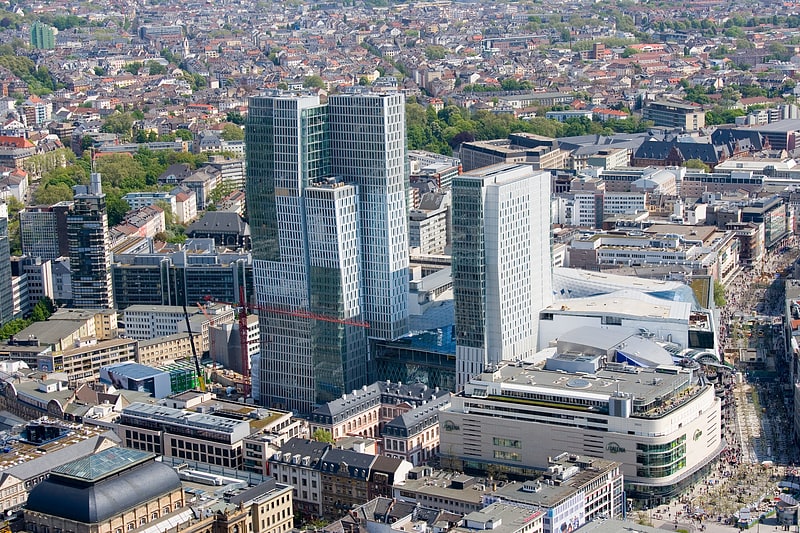
Street in Frankfurt, Germany. The Zeil is a street in the city centre of Frankfurt, Germany. The name, which dates back to the 14th century, is derived from the German word Zeile "row" and originally referred to a row of houses on the eastern end of the north side; the name was not extended to the entire street until later.
Since the end of the 19th century it has been one of the most famous and busiest shopping streets in Germany. Before World War II it was also known for its grand buildings, but most of them were destroyed and not rebuilt. The western part of the Zeil is a pedestrian zone between two large plazas, Hauptwache in the west and Konstablerwache in the east. These two plazas serve as major intersections for underground trains, trams and buses. The eastern part of the Zeil, called "New Zeil", connects Konstablerwache with the Friedberger Anlage.
The Zeil underwent a major renovation from spring 2008 until summer 2009. The pedestrian zone was extended to the west as far as the Börsenstraße. This brought drastic changes for motorists because the route via Hauptwache, which is an important north-south connection for individual traffic, was closed.[1]
Goethestraße

Street in Frankfurt, Germany. Goethestraße is a luxury shopping street in the city centre of Frankfurt, Germany, located between Opernplatz and Börsenstraße and Goetheplatz in the district of Innenstadt and within the Opera Quarter and the broader central business district known as the Bankenviertel. It is a parallel street of Freßgass and located in the immediate vicinity of Kaiserhofstraße. The street is Germany's third-busiest luxury shopping street.
The street was constructed between 1892 and 1894 and named for Johann Wolfgang von Goethe.[2]
Skyline Plaza
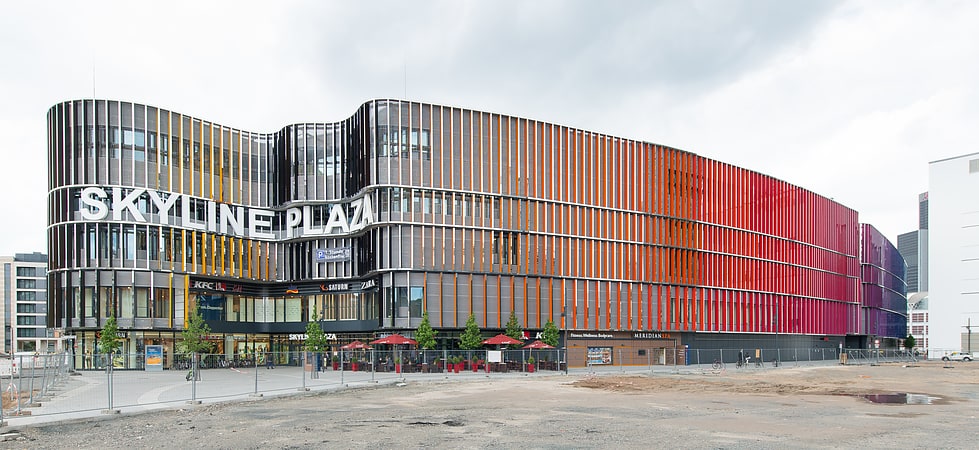
Building complex. Skyline Plaza is a building complex in the western part of Frankfurt, Germany, near the trade fair premises of Messe Frankfurt. It is planned to consist of four buildings:
- a shopping mall with around 180 shops and restaurants (opened on 29 August 2013) and a large spa (opening scheduled for February 2014)
- a congress center for Messe Frankfurt (opening scheduled for June 2014)
- a 191 m (627 ft) office tower (under construction)
- Grand Tower: a 180 m (590 ft) residential tower (finished)
Address: Europa-Allee 6, 60327 Frankfurt am Main (Innenstadt)
Städel Museum
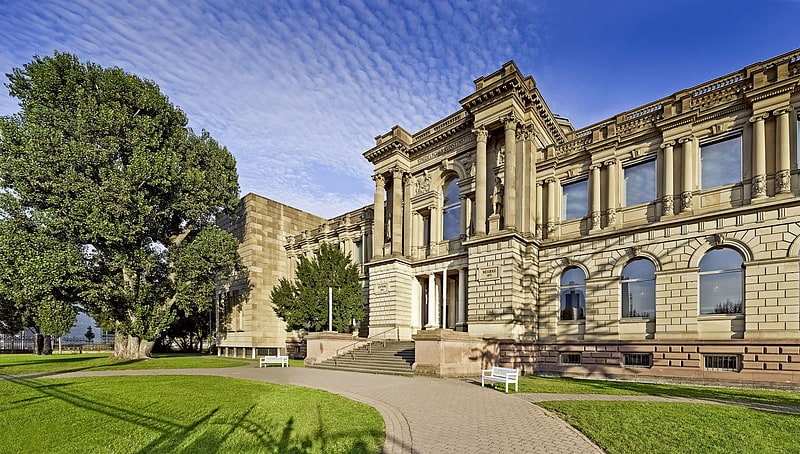
Also known as: Städelsches Kunstinstitut
European art from 14th century to today. The Städel, officially the Städelsches Kunstinstitut und Städtische Galerie, is an art museum in Frankfurt, with one of the most important collections in Germany. The Städel Museum owns 3,100 paintings, 660 sculptures, more than 4,600 photographs and more than 100,000 drawings and prints. It has around 4,000 m2 of display and a library of 115,000 books.
The Städel was honoured as "Museum of the Year 2012" by the German art critics association AICA in 2012. In the same year the museum recorded the highest attendance figures in its history, of 447,395 visitors. In 2020 the museum had 318,732 visitors, down 45 percent from 2019, due to the COVID-19 pandemic. It ranked 71st on the list of most-visited art museums in 2020.[4]
Address: Schaumainkai 63, 60596 Frankfurt am Main (Süd)
Naturmuseum Senckenberg
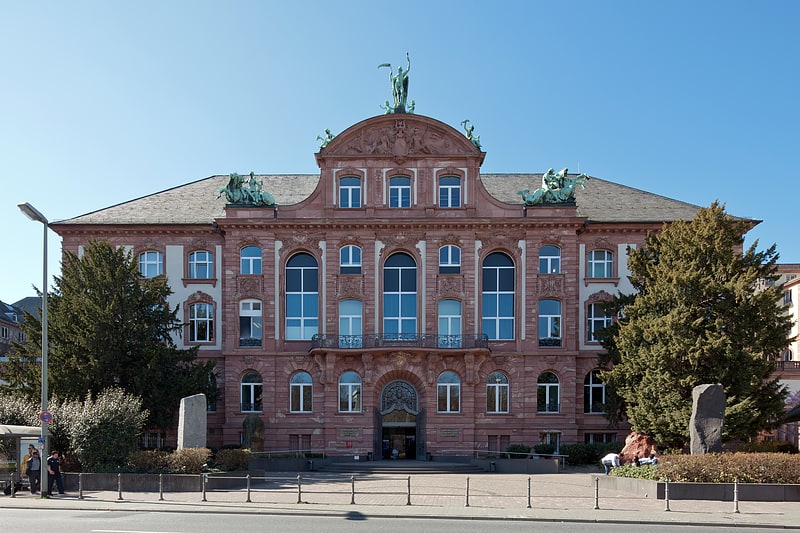
Also known as: Senckenberg Naturmuseum
Established natural history museum. The Naturmuseum Senckenberg is a museum of natural history, located in Frankfurt am Main. It is the second-largest of its type in Germany. The museum contains a large and diverse collection of birds with 90,000 bird skins, 5,050 egg sets, 17,000 skeletons, and 3,375 spirit specimens. In 2010, almost 517,000 people visited the museum.
The building housing the Senckenberg Museum was erected between 1904 and 1907 outside of the center of Frankfurt in the same area as the Johann Wolfgang Goethe University, which was founded in 1914. The museum is owned and operated by the Senckenberg Nature Research Society, which began with an endowment by Johann Christian Senckenberg.
Attractions include a Diplodocus (donated by the American Museum of Natural History on the occasion of the present museum building's inauguration in 1907), the crested Hadrosaur Parasaurolophus, a fossilized Psittacosaurus with clear bristles around its tail and visible fossilized stomach contents, and an Oviraptor. Big public attractions also include the Tyrannosaurus rex, an original of an Iguanodon, and the museum's mascot, the Triceratops.
The Senckenberg Museum also has a large collection of animal exhibits from every epoch of Earth's history. For example, the museum houses many originals from the Messel pit: field mice, reptiles, fish and a predecessor to the modern horse that lived about 50 million years ago and stood less than 60 cm tall.
Unique in Europe is a cast of the famous Lucy, an almost complete skeleton of the upright hominid Australopithecus afarensis. Historical cabinets full of stuffed animals are arranged in the upper levels; among other things one can see one of twenty existing examples of the quagga, which has been extinct since 1883. Since the remodeling finished in 2003, a new reptile exhibit addresses both the biodiversity of reptiles and amphibians and the topic of nature conservation.[5]
Address: Senckenberganlage 25, 60325 Frankfurt am Main (Innenstadt)
Freßgass
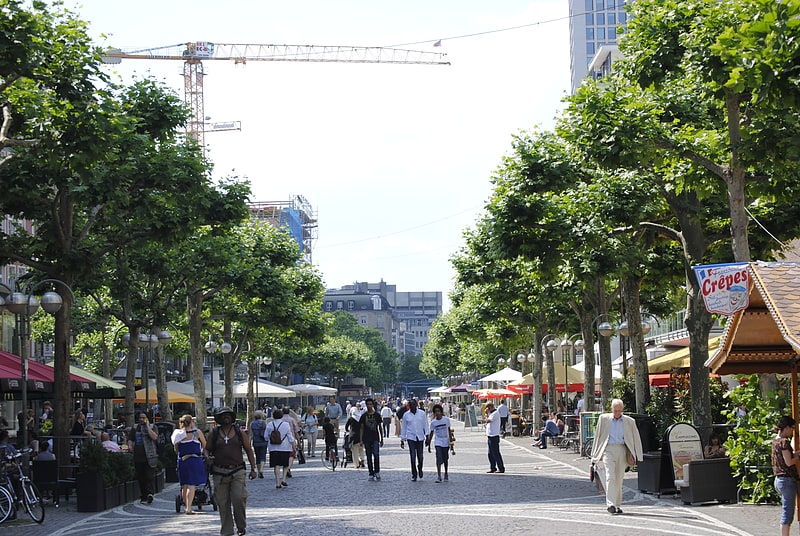
Street in Frankfurt, Germany. Freßgass is an upmarket shopping street in the city centre of Frankfurt, Germany, located in the district of Innenstadt and within the central business district known as the Bankenviertel. It is commonly regarded as Frankfurt's culinary main street. The street is a broad pedestrian zone, and is located between Hochstraße and the Opernplatz with the Alte Oper in the west and the Börsenstraße with the Frankfurt Stock Exchange in the east. The street is also the direct continuation of the Zeil, and is a parallel street of Goethestraße, Germany's best known luxury shopping street. In recent years Freßgass has increasingly become a luxury shopping street, serving as an extension of the Goethestraße in this regard. Its other primary adjacent street is the Kaiserhofstraße.
Freßgass was originally an unofficial name, adopted around 1900 by its local population, for the streets Kalbächer Gasse and Große Bockenheimer Straße, because of their many high-end food shops, bakeries and butcheries, making it the most famous food shopping street serving the bourgeoisie of the Westend. Today the Freßgass is famous as the street where the bankers from the Bankenviertel meet for lunch; banker Alex Bergen notes that "around 90% of the meeting and greeting between M&A bankers happens in one street – the Fressgass." In 1977, the name Freßgass became an official name for the streets Kalbächer Gasse and Große Bockenheimer Straße.
Since 1977, the Rheingau Wine Festival takes place annually during the late summer in Freßgass, showcasing wineries from Rheingau and Rheinhessen.
The real estate prices in Freßgass and its adjacent streets are the highest in Frankfurt. The Freßgass itself has the third highest rent after its two neighbouring streets, the Goethestraße and the Zeil. Freßgass features the flagship Frankfurt Apple Store, the French luxury sound system vendor Devialet, a Tesla store, many high-end fashion boutiques in addition to many specialty food shops and restaurants.[6]
Sachsenhausen

Frankfurt am Main. Sachsenhausen-Nord and Sachsenhausen-Süd are two quarters of Frankfurt am Main, Germany. The division into a northern and a southern part is mostly for administrative purposes as Sachsenhausen is generally considered a single entity. Both city districts are part of the Ortsbezirk Süd.
As a whole, Sachsenhausen is the largest district by population and area in Frankfurt. It is located south of the Main river and borders the districts of Niederrad and Flughafen to the west and Oberrad to the east. Sachsenhausen-Süd is mostly comprised by the Frankfurt City Forest.
Sachsenhausen was founded as Frankfurt's bridgehead in the 12th century. The oldest documents point to the year 1193. Unlike Frankfurt's own historic city center, which burned to the ground after British bombing in 1944, Sachsenhausen's old town is partly preserved. The Frankfurt youth hostel is located on its riverside. The population of Sachsenhausen is 55,422.
The River Main embankment hosts the city's largest flea market and some of Germany's best-known museums; it is also called the Museum Embankment (or Museumsufer). Here it is where the annual Museum-Embankment-Festival / Night of the Museums (or Museumsuferfest / Nacht der Museen), with all museums open throughout the night and discounted entrance fees as well as many open-air events in the streets, is held. Sachsenhausen is known for its vibrant nightlife sporting over two dozen bars, taverns and restaurants in the southern part's old town.
The main street of Sachsenhausen is Schweizer Straße, a cosmopolitan boulevard with bars and two of Frankfurt's most traditional cider houses, Zum gemalten Haus and Wagner. Ciderhouses that produce their own 'Apfelwein' (applewine) can be identified by the presence of a wreath of evergreen branches hanging outside the location or a similar image included on their signpost. The Textorstraße and the old town or 'Altstadt' have the best known ciderhouses in Frankfurt, but such pubs can be found all over southern Hesse. Orchards of the Sperling apple can be seen across the countryside and, reputedly, local law requires that Apfelwein be the cheapest alcoholic beverage on sale in any public house.
In addition, there is a brand new part of Sachsenhausen, built on the grounds of the old slaughterhouse area. Try to find the area from Deutschherrnufer numbered between 40 and 50. The area is located directly opposite the new seat of the European Central Bank on the other side of the river.
Landmarks of Sachsenhausen are the Henninger Turm and the Goetheturm.
Sachsenhausen is also the location of the Sankt Georgen Graduate School of Philosophy and Theology.[7]
Palmengarten
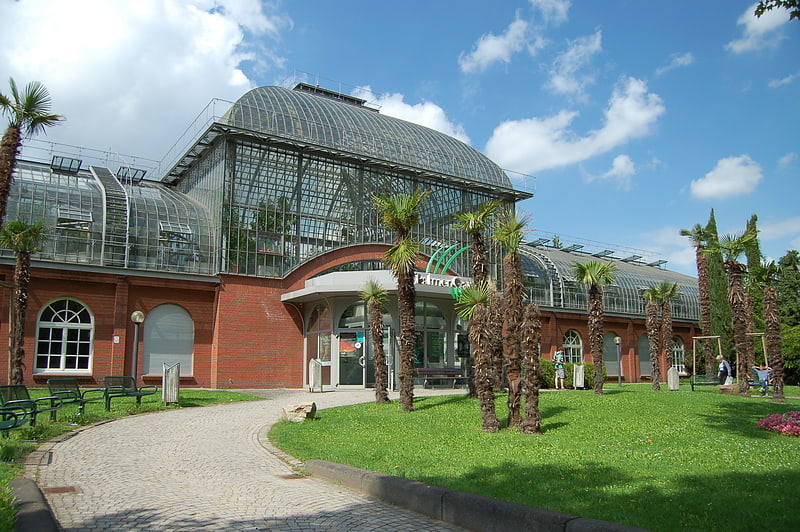
Botanical garden with huge greenhouses. The Palmengarten is one of three botanical gardens in Frankfurt am Main, Germany. It is located in the Westend-Süd district. It covers a surface of 22 hectares. It is a major tourist attraction.[8]
Address: Siesmayerstr. 61, 60323 Frankfurt (Innenstadt)
Zoo Frankfurt
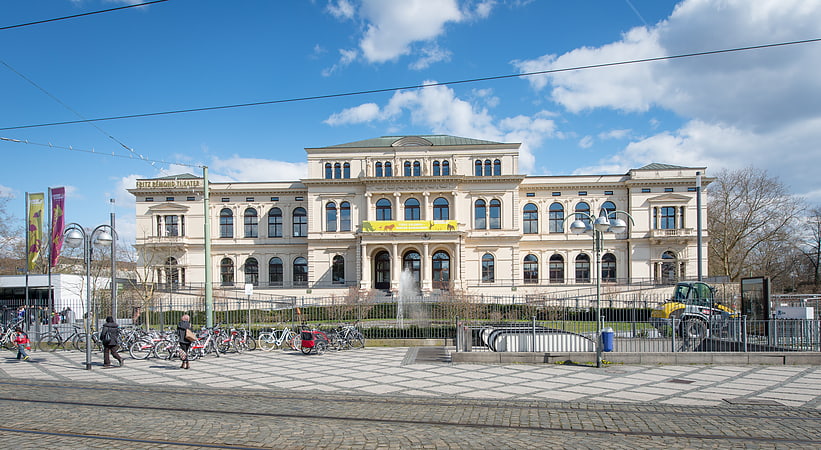
Zoo in Frankfurt, Germany. The Frankfurt Zoological Garden is the zoo of Frankfurt, Germany. It features over 4,500 animals of more than 510 species on more than 11 hectares. The zoo was founded in 1858 and is the second oldest zoo in Germany, after Berlin Zoological Garden. It lies in the eastern part of the Innenstadt. Bernhard Grzimek was director of the zoo after World War II from 1945 until 1974.
The Frankfurt Zoological Society (FZS) was founded in 1858 by citizens of Frankfurt to establish the Zoological Garden, which it operated until the First World War. The city council then assumed responsibility for the zoo until 1950, when the FZS again became the zoo's development association.[9]
Address: Alfred-Brehm-Platz 16, 60316 Frankfurt am Main (Innenstadt)
Caricatura
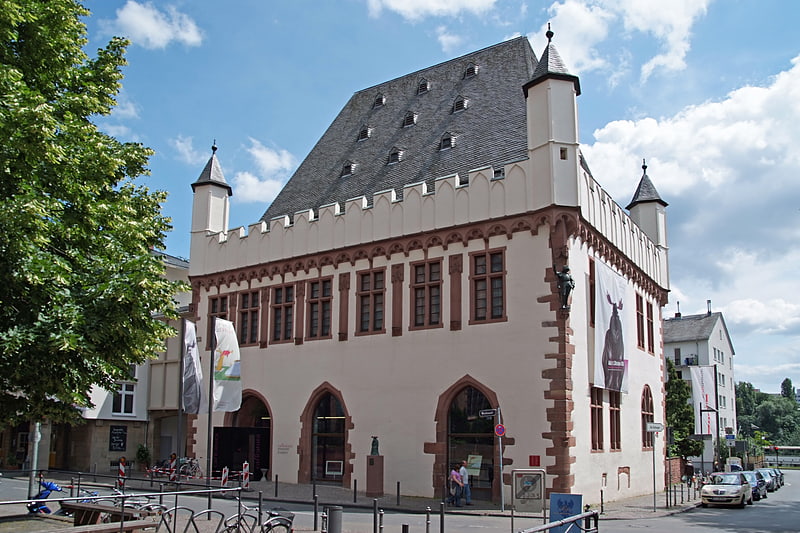
The Caricatura Museum, official name Caricatura Museum für Komische Kunst, is a museum for comic art in Frankfurt, Hesse, Germany. It shows a in a permanent exhibition works by the artists of the Neue Frankfurter Schule, and additionally exhibitions of contemporary artists.[10]
Address: Weckmarkt 17, 60311 Frankfurt am Main (Innenstadt)
Museum Angewandte Kunst

Design museum in a 19th-century villa. The Museum Angewandte Kunst is located in Frankfurt am Main, Germany and part of the Museumsufer. The alternating exhibitions recount tales of cultural values and changing living conditions. Beyond that, they continually refer to the question of what applied art is today and can be and demonstrate the field of tension between function and aesthetic value.[11]
Address: Schaumainkai 17, 60594 Frankfurt am Main (Süd)
Deutsches Filmmuseum
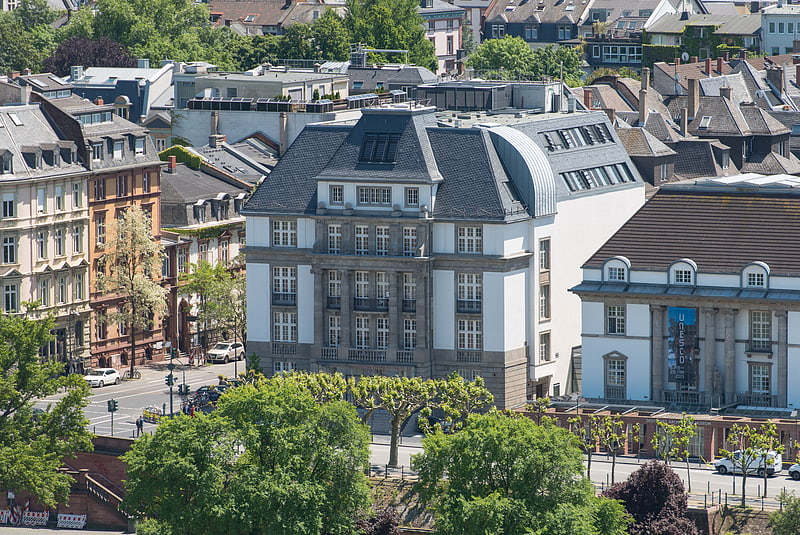
The Deutsches Filminstitut – DIF is an institute for the study of film, based in Frankfurt am Main, Germany.[12]
Address: Schaumainkai 41, 60596 Frankfurt am Main (Süd)
Frankfurt Cathedral
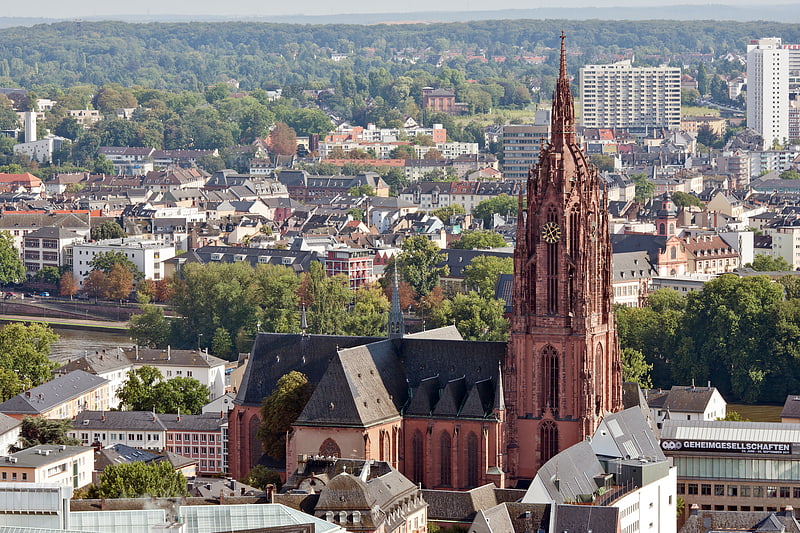
Also known as: Kaiserdom St. Bartholomäus
Soaring Gothic structure with city views. Frankfurt Cathedral, officially Imperial Cathedral of Saint Bartholomew is a Roman Catholic Gothic church located in the centre of Frankfurt am Main, Germany. It is dedicated to Saint Bartholomew.
It is the largest religious building in the city and a former collegiate church. Despite its common English name, it has never been a true cathedral (episcopal see), but is called the Kaiserdom (an "imperial great church" or imperial cathedral) or simply the Dom due to its importance as former election and coronation church of the Holy Roman Empire. As one of the major buildings of the Empire's history, it was a symbol of national unity, especially in the 19th century.
The present church building is the third church on the same site. Since the late 19th century, excavations have revealed buildings that can be traced back to the 7th century. The history is closely linked with the general history of Frankfurt and Frankfurt's old town because the cathedral had an associated role as the religious counterpart of the Royal Palace in Frankfurt.[13]
Address: Domplatz 1, 60311 Frankfurt am Main (Innenstadt)
Opernplatz
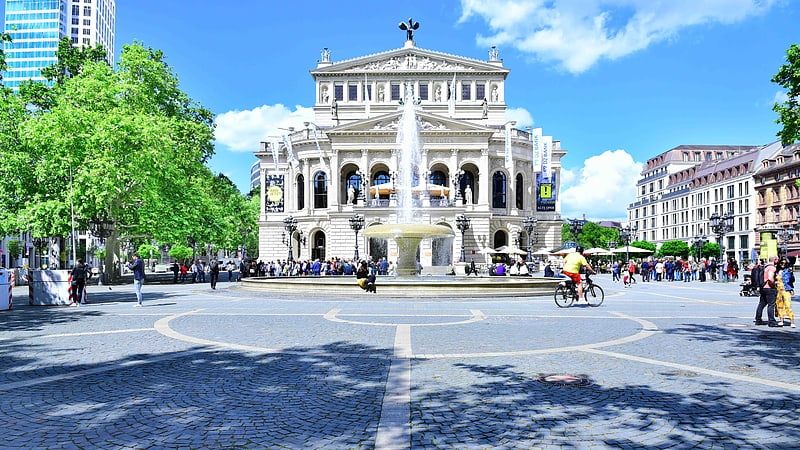
The Opernplatz is a central city square in Frankfurt, Germany, located in the district of Innenstadt and within the central business district known as the Bankenviertel. The Opernplatz is the most central square of the Bankenviertel. It is named for the Alte Oper building, which today serves as a concert hall. The Sofitel Frankfurt Opera hotel is located at Opernplatz 14. The Opera Quarter with some of Germany's most well known luxury shopping streets is located to the east of Opernplatz.
The seven adjacent streets are:
- Goethestraße, one of Germany's most exclusive shopping streets
- Große Bockenheimer Straße, better known as Freßgass
- Neue Mainzer Straße, leading to the centre of the Bankenviertel
- Hochstraße
- Bockenheimer Anlage
- Taunusanlage
- Bockenheimer Landstraße
Address: Opernplatz 14, Frankfurt (Innenstadt)
Römer

Iconic town hall since 1405 with balcony. The Römer is a medieval building in the Altstadt of Frankfurt am Main, Germany, and one of the city's most important landmarks. The Römer is located opposite the Old St. Nicholas church and has been the city hall of Frankfurt for over 600 years. The Römer merchant family sold it together with a second building, the Goldener Schwan, to the city council on March 11, 1405 and it was converted for use as the city hall. The Haus Römer is actually the middle building of a set of three located in the Römerberg plaza.
The Römer is not a museum as it is occasionally used by the city for various purposes, for example as a Standesamt or civil registration office; the wedding rooms are located in the first and second floor of the Haus Löwenstein.
The former old town quarter between the Römer and St. Bartholomew's Cathedral has been redeveloped as the Dom-Römer Quarter until 2018, including several reconstructions of historical buildings that were destroyed during World War II.[15]
Address: Römerberg 19, 60311 Frankfurt am Main (Innenstadt)
Schirn Kunsthalle Frankfurt

Gallery for major modern art exhibitions. The Schirn Kunsthalle is a Kunsthalle in Frankfurt, Germany, located in the old city between the Römer and the Frankfurt Cathedral. The Schirn exhibits both modern and contemporary art. It is the main venue for temporary art exhibitions in Frankfurt. Exhibitions in recent years included retrospectives of Wassily Kandinsky, Marc Chagall, Frida Kahlo, Alberto Giacometti, Bill Viola, and Yves Klein. The Kunsthalle opened in 1986 and is financially supported by the city and the state. Historically, the German term "Schirn" denotes an open-air stall for the sale of goods, and such stalls were located here until the 19th century. The area was destroyed in 1944 during the Second World War and was not redeveloped until the building of the Kunsthalle. As an exhibition venue, the Schirn enjoys national and international renown, which it has attained through independent productions, publications, and exhibition collaborations with museums such as the Centre Pompidou, the Tate Gallery, the Solomon R. Guggenheim Museum, the Hermitage Museum, or the Museum of Modern Art.[16]
Address: Römerberg 6, 60311 Frankfurt am Main (Innenstadt)
Main Tower

Panoramic views from 200m-high building. Main Tower is a 56-storey, 200 m skyscraper in the Innenstadt district of Frankfurt, Germany. It is named after the nearby Main river. The building is 240 m when its antenna spire is included.
The tower has five underground floors and two public viewing platforms. It is the only skyscraper in Frankfurt with a public viewing observatory. It is the 4th tallest building in Frankfurt and the 4th tallest in Germany, tied with Tower 185.
The foyer of the building has two art pieces accessible to the public: the video installation by Bill Viola "The World of Appearances" and the wall mosaic by Stephan Huber "Frankfurter Treppe / XX. Jahrhundert" ("Frankfurt's Steps/20th century").
The tower's design features what appears to be two connected towers. The smaller of the two is of a cuboid shape and a design common to 1970s architecture. The second and taller of the two towers is a circular tower with an entire blue glass exterior which features the transmission tower on top.[17]
Address: Neue Mainzer Str. 52 - 58, 60311 Frankfurt (Innenstadt)
Old Jewish Cemetery
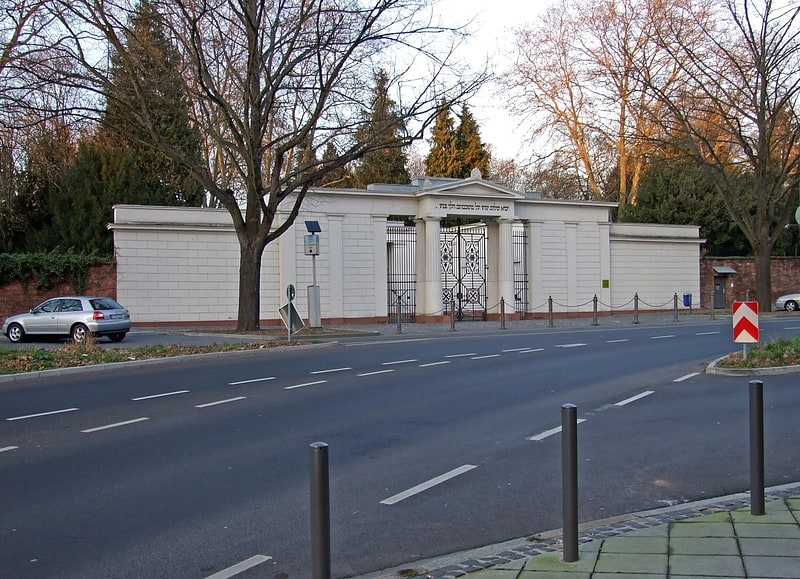
Also known as: Alter jüdischer Friedhof Rat-Beil-Straße
Cemetery in Frankfurt, Germany. The Old Jewish Cemetery of Frankfurt is located at Rat-Beil-Straße directly adjacent to the oldest parts of the gentile Frankfurt Main Cemetery. Together, Frankfurt Main Cemetery, the Old Jewish Cemetery and the New Jewish Cemetery constitute one of the largest cemetery areas in Germany. The Old Jewish Cemetery is noted for many monumental graves and includes the graves of many notable individuals. The Old Jewish Cemetery is the largest of Frankfurt's twelve Jewish cemeteries.
It was opened, together with the Main Cemetery, in 1828. By 1928, when the cemetery was closed for new graves because it was full, there were around 40,000 burials on the cemetery. Since 1928, interment has only been possible in already established graves. In its place, the New Jewish Cemetery was opened in 1928.[18]
Goethe House
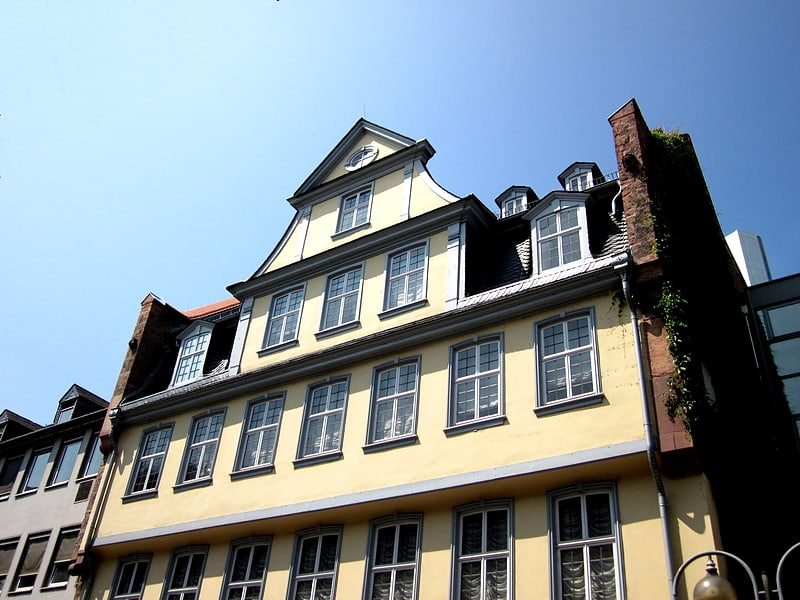
Also known as: Goethe-Haus
Goethe's birthplace and exhibition room. The Goethe House is a writer's house museum in the Innenstadt district of Frankfurt am Main, Germany. It is a birthplace of Johann Wolfgang von Goethe. Decorated with period furniture and paintings, it provides an authentic environment in which Goethe spent his youth. It is also a place where Goethe wrote his famous works Götz von Berlichingen, Faust and The Sorrows of Young Werther.[19]
Address: Großer Hirschgraben 23-25, 60311 Frankfurt am Main (Innenstadt)
Weltkulturen Museum
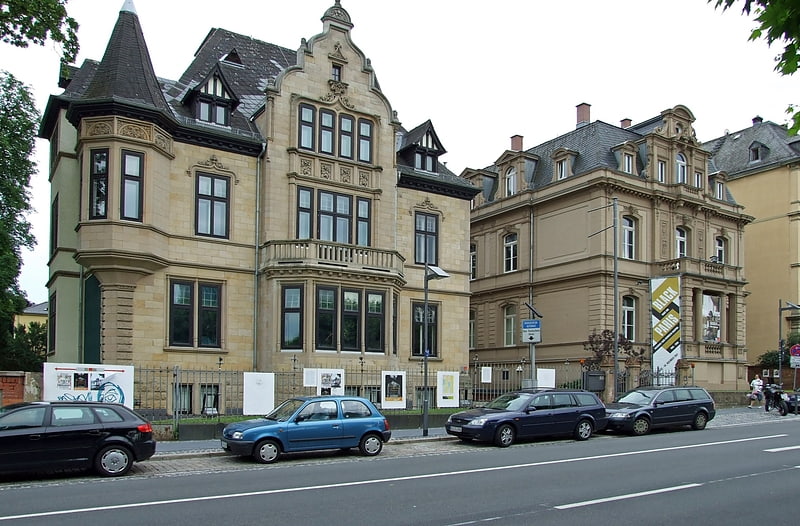
Museum in Frankfurt, Germany. The Museum of World Cultures is an ethnological museum in Frankfurt, Germany. Until 2001 it was called the Museum of Ethnology.[20]
Address: Schaumainkai 29, 60594 Frankfurt am Main (Süd)
Historical Museum
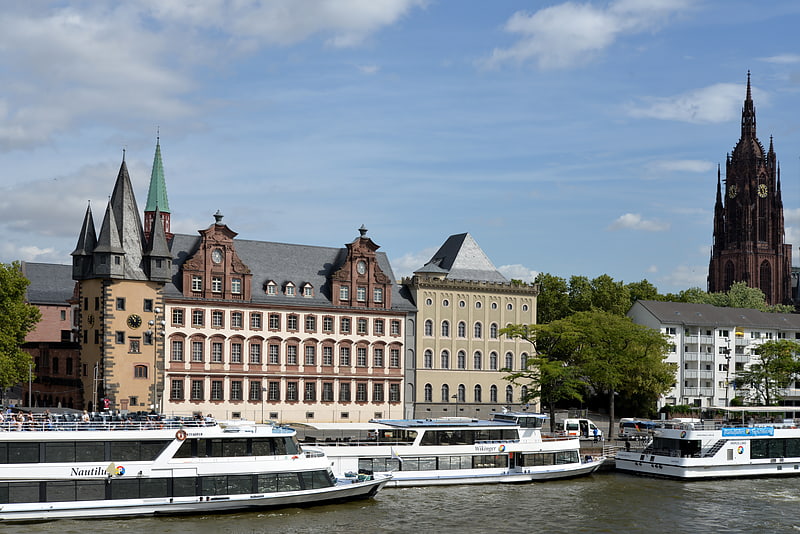
Also known as: Historisches Museum Frankfurt
Museum of city's culture, art and history. The Historical Museum in Frankfurt am Main, Germany, was founded in 1878, and includes cultural and historical objects relating to the history of Frankfurt and Germany. It moved into the Saalhof in 1955, and a new extension was opened in 1972.
The 1970s extension is currently being replaced by a modern new exhibition building and a small administration building which are expected to be completed by 2015.[21]
Address: Saalhof 1, 60311 Frankfurt am Main (Innenstadt)
Museum für Moderne Kunst

Contemporary art in postmodern building. The Museum für Moderne Kunst, or short MMK, in Frankfurt, was founded in 1981 and opened to the public June 6, 1991. The museum was designed by the Viennese architect Hans Hollein. Because of its triangular shape, it is popularly called "piece of cake", Claes Oldenburg artistically has expressed in a work.[22]
Address: Domstraße 10, 60311 Frankfurt am Main (Innenstadt)
Paulskirche
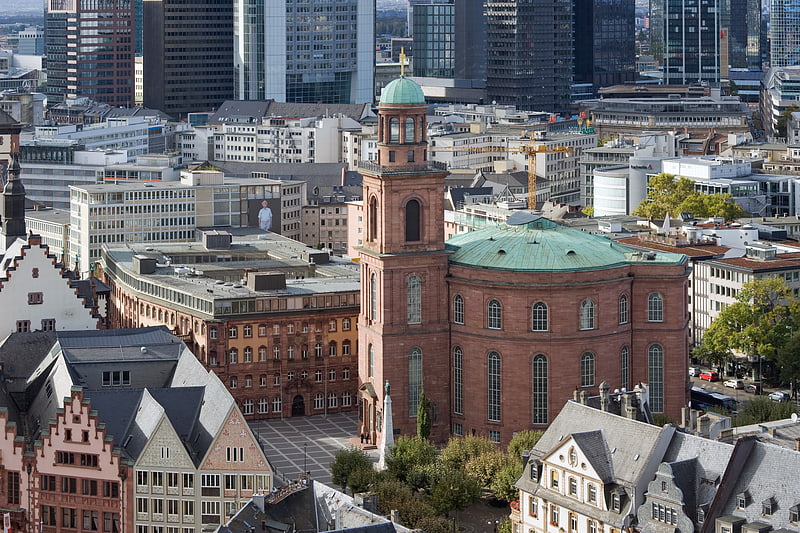
Event venue in Frankfurt, Germany. St Paul's Church is a former Protestant church in Frankfurt, Germany, used as a national assembly hall. Its important political symbolism dates back to 1848 when the Frankfurt Parliament convened there, the first publicly and freely-elected German legislative body.[23]
Address: Paulsplatz 11, 60311 Frankfurt am Main (Innenstadt)
Alte Nikolaikirche
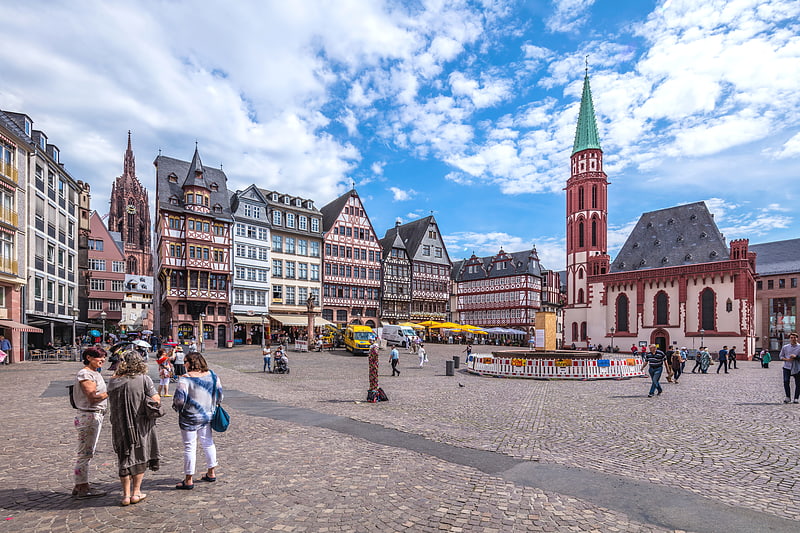
Small medieval Gothic church. The Old St Nicholas Church in Frankfurt, Germany, is a medieval Lutheran church. It is located near the Römer city hall in Frankfurt's old town called Altstadt. It has 51 bells; 4 are used for peals and 47 are used for carillons. The first chapel on its site was built in the mid-12th century, the current in the mid-15th. Its congregation forms part of today's Protestant Church in Hesse and Nassau, comprising Lutheran, Reformed and United Protestant congregations.
Despite major destruction in the surrounding old town owing to the bombing of Frankfurt am Main in World War II, the Old St Nicholas Church had only minor damage. Nearby, the Dom-Römer Project aims to bring back parts of the old town between the Römerberg square and Frankfurt Cathedral.[24]
Address: Römerberg 11, 60311 Frankfurt am Main (Innenstadt)
Kaiserhofstraße
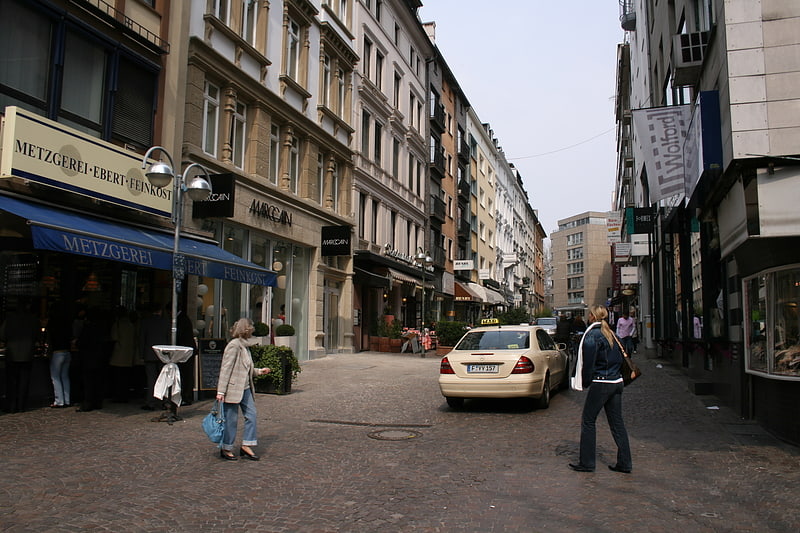
Street in Frankfurt, Germany. The Kaiserhofstraße is a short, mostly pedestrian upmarket street in the city centre of Frankfurt, Germany, located in the Opera Quarter in the western part of the district of Innenstadt, within the central business district known unofficially as the Bankenviertel.
The 130 meter long street runs from the Freßgass pedestrian main street to Hochstraße, and is situated between Kleine Hochstraße and Börsenstraße ("Stock Exchange Street"). It is located in the immediate vicinity of the Wallanlagen park, which is located just across the street to the north of Kaiserhofstraße, and of the Opera Square with the Old Opera, the Frankfurt Stock Exchange, the Sofitel Frankfurt Opera luxury hotel, and Germany's most well-known luxury shopping street Goethestraße. In recent years Kaiserhofstraße has also increasingly become a luxury shopping street as some stores from Goethestraße have moved to Kaiserhofstraße a minute's walk away. The street is also located in close proximity to numerous large financial institutions.
The street is mainly occupied by office spaces, especially for boutique financial institutions such as investment and wealth management firms, select residential apartments, high-end fashion businesses, and four restaurants. The rent in the area surrounding Freßgass is the highest in Frankfurt.[25]
Römerberg
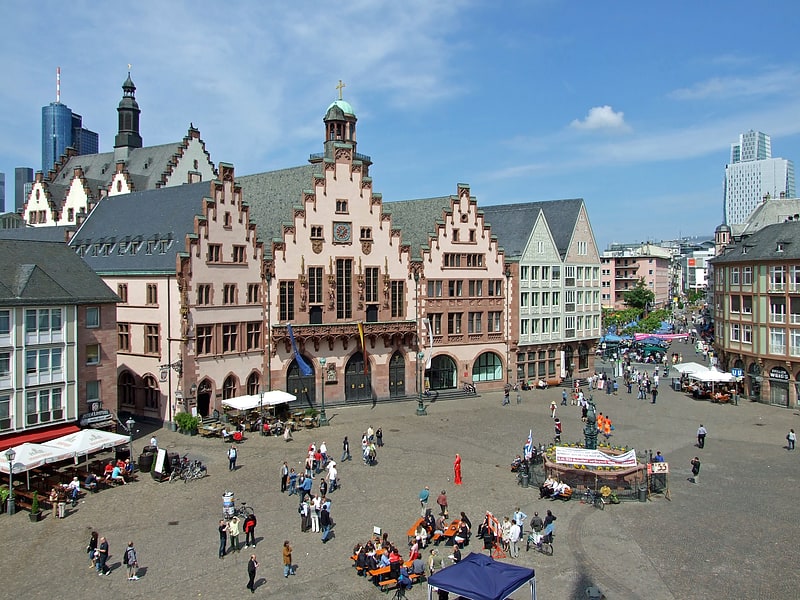
Picturesque timber houses on town square. Römerberg, also spelled as "Roemerberg" is a public space in Frankfurt, Germany. It is located in front of the Römer building complex, seat of the Frankfurt city administration since the 15th century. As the site of numerous Imperial coronations, trade fairs and Christmas markets, the square is the historic heart of the medieval Altstadt and today a popular tourist destination.
Paulsplatz, another historic square, is to the north. The Old St Nicholas Church and Historical Museum are to the south. Beyond that is Mainkai on the River Main. On the west side of the square is the reconstructed Römer medieval building. To the east is the Dom-Römer Project and beyond that is Frankfurt Cathedral.
Römerberg is a major location for the outdoor Frankfurt Christmas Market.
It was the site of a Nazi book burning in 1933.[26]
Address: Römerberg 27, Frankfurt (Innenstadt)
Commerzbank-Arena
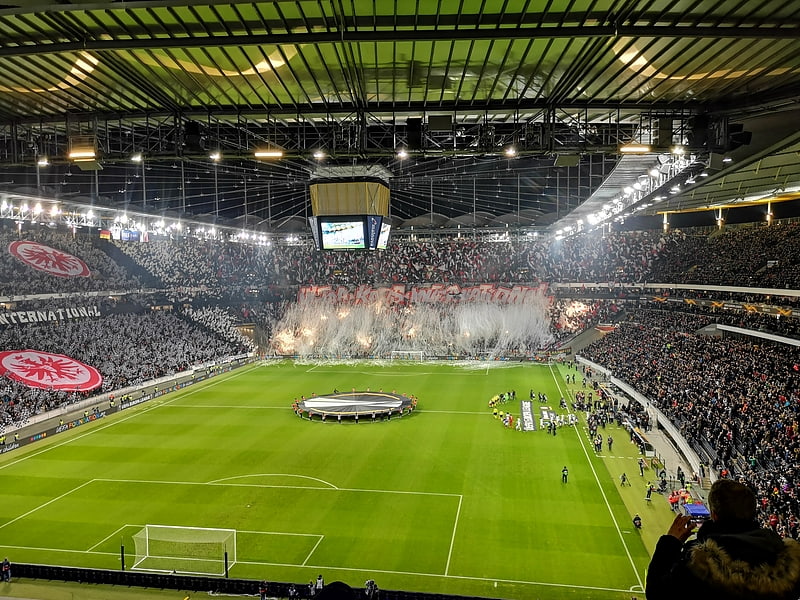
Arena in Frankfurt, Germany. The Waldstadion, currently known as the Deutsche Bank Park for sponsorship purposes, and formerly known as the Commerzbank-Arena, is a retractable roof sports stadium in Frankfurt, Hesse, Germany. The home stadium of the football club Eintracht Frankfurt, it was opened in 1925. The stadium has been upgraded several times since then; the most recent remodelling was its redevelopment as a football-only stadium in preparation for the 2005 FIFA Confederations Cup and 2006 FIFA World Cup. With a capacity of 51,500 spectators for league matches and 48,500 for American football and international matches, it is among the ten largest football stadiums in Germany. The stadium was one of the nine venues of 2011 FIFA Women's World Cup, and hosted four matches including the final.
The sports complex, which is owned by the city of Frankfurt, includes the actual stadium and other sports facilities, including a swimming pool, a tennis complex, a beach volleyball court and a winter sports hall. The arena has its own railway station, Frankfurt Stadion, on the national rail network.[27]
Address: Frankfurt, Mörfelder Landstraße 362
Alte Oper
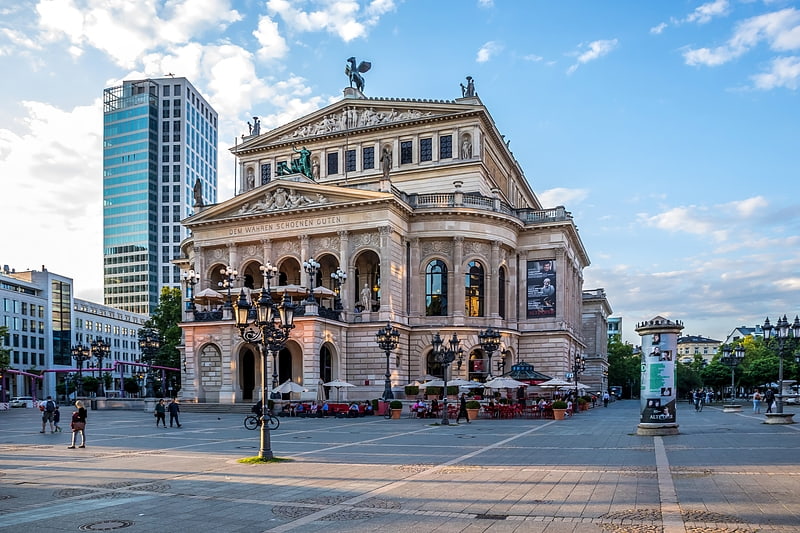
Grand 19th-century concert hall. Alte Oper is a concert hall in Frankfurt am Main, Hesse, Germany. It is located in the inner city, Innenstadt, within the banking district Bankenviertel. Today's Alte Oper was built in 1880 as the city's opera house, which was destroyed by bombs in 1944. It was rebuilt in the 1970s as a concert hall with a large hall and smaller venues, opened in 1981. The square in front of the building is still known as Opernplatz.
Many important works were performed for the first time when it was Frankfurt's opera house, including Schreker's Der ferne Klang and Carl Orff's Carmina Burana in 1937. The Oper Frankfurt now plays in the Opern- und Schauspielhaus Frankfurt, completed in 1951.[28]
Address: Opernplatz 1, 60313 Frankfurt (Innenstadt)
Deutsches Architekturmuseum
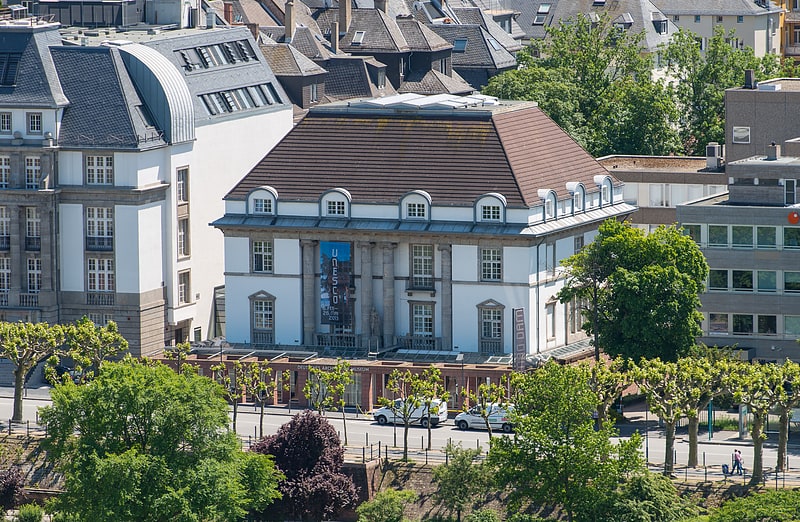
Museum in Frankfurt, Germany. The German Architecture Museum is located on the Museumsufer in Frankfurt, Germany. Housed in an 18th-century building, the interior has been re-designed by Oswald Mathias Ungers in 1984 as a set of "elemental Platonic buildings within elemental Platonic buildings". It houses a permanent exhibition entitled "From Ancient Huts to Skyscrapers" which displays the history of architectural development in Germany.
The museum organises several temporary exhibitions every year, as well as conferences, symposia and lectures. It has a collection of ca. 180,000 architectural drawings and 600 models, including works by modern and contemporary classics like Erich Mendelsohn, Mies van der Rohe, Archigram and Frank O. Gehry. It also includes a reference library with approximately 25,000 books and magazines.[29]
Address: Schaumainkai 43, 60596 Frankfurt am Main (Süd)
Frankfurter Engel
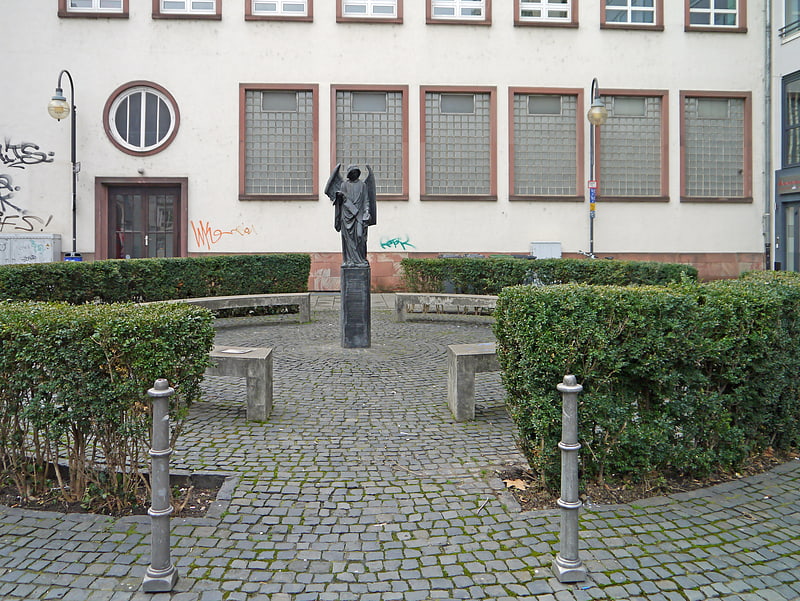
Sculpture by Rosemarie Trockel. The Frankfurter Engel is a memorial in the city of Frankfurt am Main in southwestern Germany; it is dedicated to homosexual people who were persecuted under Nazi rule, and as well as under Paragraph 175 of the German Criminal Code during the 1950s and 1960s.[30]
Portikus

Art gallery in Frankfurt, Germany. Portikus is an exhibition hall for contemporary art in Frankfurt am Main, that was founded in 1987 by Kasper König. Portikus presents the work of internationally renowned artists, and exhibits younger, emerging artists. Almost always, art work is commissioned for the gallery space.[31]
Address: Alte Brücke 2, 60594 Frankfurt am Main (Süd)
Museum für Kommunikation
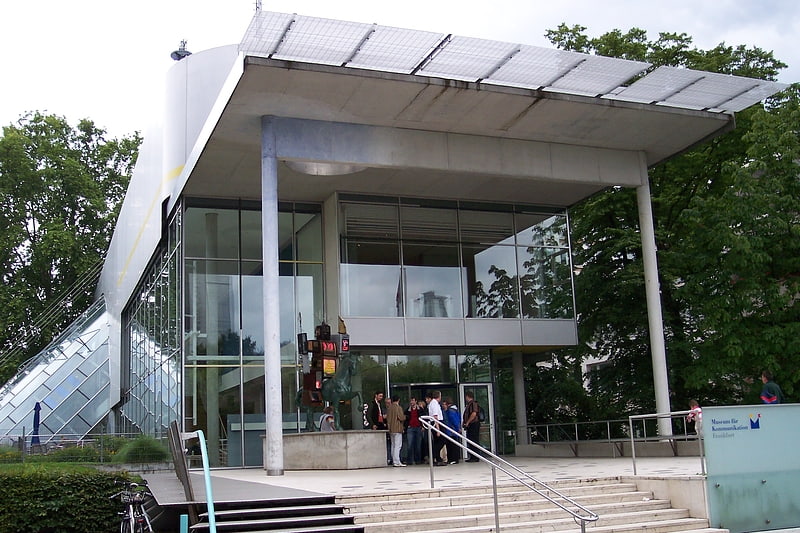
Museum in Frankfurt, Germany. The Museum für Kommunikation is a museum of the history of communication in Frankfurt, Germany. It opened on 31 January 1958 under the name Bundespostmuseum and is the oldest museum on Frankfurt's Museumsufer.
The museum was owned by Deutsche Bundespost until 1994. The present building, a modern and transparent glass structure, opened in 1990 and was designed by architect Günter Behnisch. Following the opening of the new building, the museum acquired its present name, and it is now managed by the Museum Trust for Post and Telecommunications, which was established in 1995 during the federal postal reforms that followed re-unification.[32]
Address: Schaumainkai 53, 60596 Frankfurt am Main (Süd)
Liebieghaus
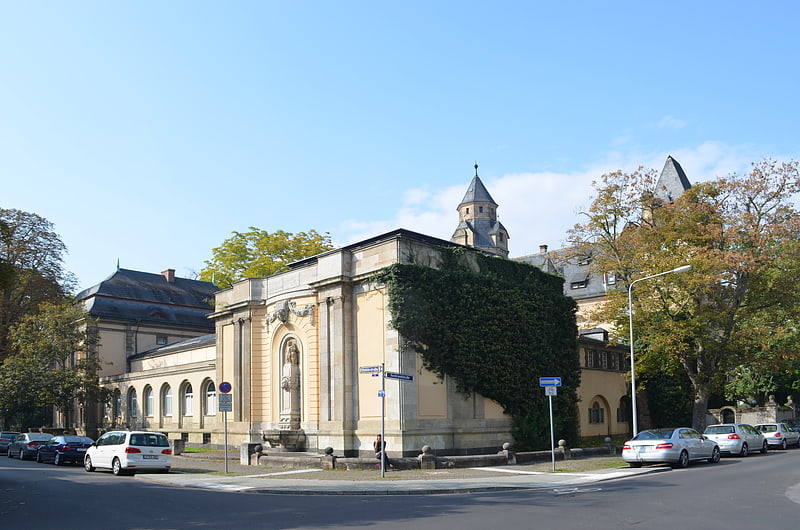
Museum in Frankfurt, Germany. The Liebieghaus is a late 19th-century villa in Frankfurt, Germany. It contains a sculpture museum, the Städtische Galerie Liebieghaus, which is part of the Museumsufer on the Sachsenhausen bank of the River Main. Max Hollein has been the director of the Städel Museum since January 2006.[33]
Address: Schaumainkai 71, 60596 Frankfurt am Main (Süd)
Wollheim Memorial
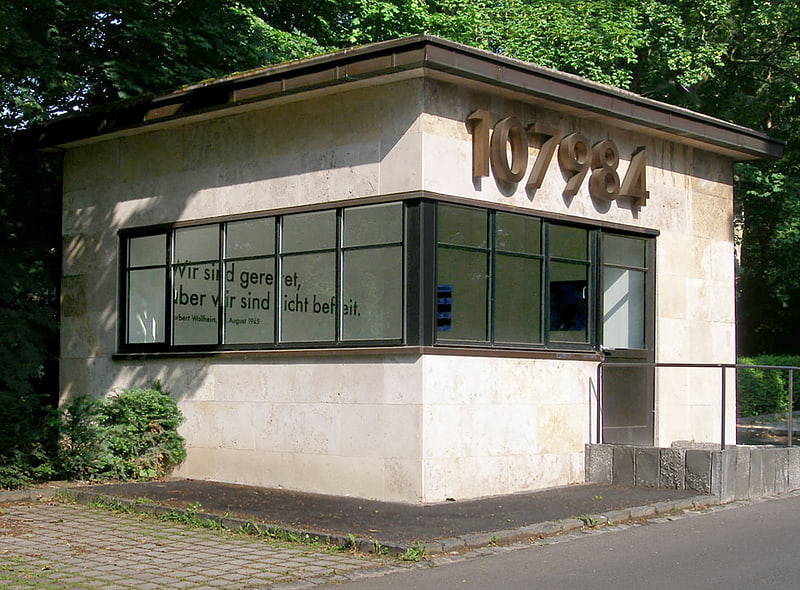
The Wollheim Memorial is a Holocaust memorial site in Frankfurt am Main.
It is named after Norbert Wollheim (1913-1998), a former member of the Board of Directors of the Central Council of Jews in Germany and forced labourer of IG Farben. Its purpose is to keep alive the memory of the victims at Buna/Monowitz and inform about their history and reparation.
Heiner Blum designed the Wollheim-Memorial and opened it on 2 November 2008. It consists of a small pavilion at Grüneburgplatz, which is now named Norbert-Wollheim-Platz, and 13 plates showing portraits of former prisoners in Buna-Monowitz. These photographs show young people who would later become imprisoned in the concentration camp Buna/Monowitz, they illustrate Jewish everyday life before Holocaust and testify devastated lifeworlds on the former grounds of IG Farben, which is today home to the humanistic and cultural studies faculty of the Goethe University Frankfurt (Campus Westend).
Above the entrance of the pavilion the prisoner number of Norbert Wollheim is installed. Inside the Wollheim quote "Wir sind gerettet, aber wir sind nicht befreit" ("We are saved but not liberated") of 26 August 1945 is placed on a wall inscription. Visitors are informed via two interactive screens by pictures, texts and documents about NS forced labour, the IG Farben lawsuits, the Auschwitz-Birkenau concentration camp and about the reparation (among other the Bundesentschädigungsgesetz and the Foundation Remembrance, Responsibility and Future).
In 24 video interviews survivors inform about their childhood, deportation, imprisonment and about their lives after the Holocaust. Norbert Wollheim also gets a chance to speak in an interview which was recorded in Washington D.C. in 1991.[34]
Museum Giersch
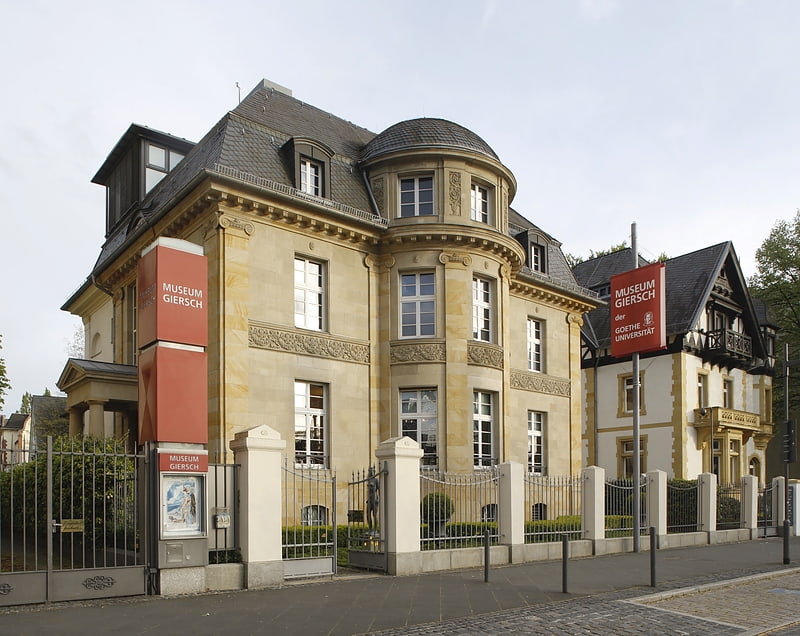
Art gallery in Frankfurt, Germany. The Museum Giersch is an art gallery on the Main River in Frankfurt am Main, Germany, in the Museumsufer area.
The museum opened in 2000. It hosts a changing series of exhibitions displaying the art and cultural history of the Rhine-Main area, with the aim of promoting the region's cultural identity. The Museum Giersch displays works on loan from public and private collections. The range of exhibits covers all areas of painting, photography, sculpture and graphic art, as well as architecture and applied art.
The gallery is situated in a neoclassical villa on the Schaumainkai, built around 1910 for the Philipp Holzmann company and now one of the few surviving riverside villas in Sachsenhausen. The renovation of the villa and its conversion into an exhibition venue were carried out by the Giersch Foundation (Stiftung Giersch), which was founded in 1994 and is the museum's sole operator.[35]
Address: Schaumainkai 83, 60596 Frankfurt am Main (Süd)